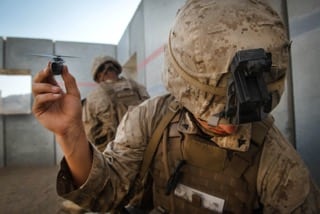Mil/Aero Connectors Lighten Up for Small UAVs
As drones take a larger role in military operations, the pressure is on to reduce size and weight. A new generation of SWaP-optimized connector products will help.
By Ann R. Thryft
Unmanned aerial vehicles (UAVs) are getting smaller and more powerful as the overall miniaturization trend expands across the broad range of military equipment. Also known as unmanned aircraft systems (UAS) or drones, these smaller aircraft are helping ground troops cover more territory more safely, since they’re far less visible than larger conventional drones.
The increased surveillance and reconnaissance capabilities of these small UAS depend on payloads that may include multiple cameras and sensors for a variety of frequencies, such as infrared, thermal, and visible light, as well as sophisticated embedded computing and storage devices. Since flight time depends on how much weight the aircraft carries, these increased payloads can make keeping weight down a challenge.

AeroVironment’s Raven RQ-11B, shown here being launched at Fort Hood, Texas, is one of the most widely deployed unmanned aircraft systems (UAS) in the world. They are used to give ground units situational awareness of their surrounding areas using low-altitude surveillance.
In general, small UAVs can be classified by their size as nano-UAVs, micro-UAVs, and small tactical UAVs, said Russ Graves, business development manager for TE Connectivity. Since these smaller drones aren’t flying at the medium and high altitudes where some MIL-STD specs come into play for larger drones, typically the technology used in much of aerospace and defense does not apply. “In many applications, a lot of these small drones, even in the tactical area, are considered expendable, meaning that if one goes down, they just send up another. In these types of applications, COTS [commercial off-the-shelf] products are acceptable,” said Graves.
Concerns about reducing size, weight, and power (SWaP) are most critical for micro-UAVs and nano-UAVs, such as the Black Hornet from FLIR Systems, one of the smallest UAVs developed for military use. It can fly for periods of up to 25 minutes per flight with a range of 1.6km (0.99mi). This nearly silent handheld craft weighs 1.3kg (2lb, 13.86oz) and can be carried on a soldier’s utility belt.
The somewhat larger RQ-11B Raven multi-rotor system by AeroVironment is one of the most widely used UAVs in the world. With a wingspan of 1.37m (4.5ft), it weighs 1.9kg (4.2lb) and has a range of 10km (6.2mi).

One of the smallest UAVs developed for military reconnaissance and situational awareness uses is FLIR Systems’ Black Hornet, shown here being prepared for testing during Marine Air Ground Task Force Integrated Experiment 2016.
As a result of efforts to optimize SWaP, trends in connectors and cabling include lighter weight materials, quick disconnects, multiple ports and multi-functions, and compact cabling. TE has several product choices for design engineers working on smaller UAVs. These range from its composite DEUTSCH 369 series connectors, which are fully sealed and can be blind-mated for rugged environments, to its Wildcat circular connectors. The company’s solution sets can address UAV data and power distribution, the UAV command and control bussing system, and all the other various signals used on UAVs, said Graves.
 Connectors used in UAVs must be capable of handling higher data rates for higher-speed digital protocols, and generally require lower voltages and lower current flow within signals, smaller packaging with higher pin counts, and EMI shielding. TE’s Cee-Lok FAS-T, for example, are small, field-terminable I/O connectors capable of 10Gb/s Ethernet, with noise cancellation and decoupling for minimizing crosstalk. They are also easily field-repairable, which is a plus in the military theater.
Connectors used in UAVs must be capable of handling higher data rates for higher-speed digital protocols, and generally require lower voltages and lower current flow within signals, smaller packaging with higher pin counts, and EMI shielding. TE’s Cee-Lok FAS-T, for example, are small, field-terminable I/O connectors capable of 10Gb/s Ethernet, with noise cancellation and decoupling for minimizing crosstalk. They are also easily field-repairable, which is a plus in the military theater.
Handheld UAVs can be either GPS-guided or radio-controlled, with very different connector needs, said Bob Stanton, director of technology at Omnetics Corporation. High-speed data transfer and GPS guidance applications are served best with coaxial signal connectors, while simpler radio-controlled UAVs can use multi-pin signal strip connectors or D-shaped connectors. Omnetics provides all three types.
 Connectors will also be different for image capture-and-send units, which may need microwave communications, versus capture-and-store units, and may need extra storage as well, said Stanton. The driving elements for camera connectors are the data capture electronics that take the pictures and the frequencies used or type of pictures. “If it’s stills and users are storing them in a data pack to be sent back later, you need a good-quality connector that’s small, rugged, and lightweight, and that plugs in and unplugs quickly,” he said. Omnetics provides nano-latching connectors and ratchet-locking circular connectors for these uses.
Connectors will also be different for image capture-and-send units, which may need microwave communications, versus capture-and-store units, and may need extra storage as well, said Stanton. The driving elements for camera connectors are the data capture electronics that take the pictures and the frequencies used or type of pictures. “If it’s stills and users are storing them in a data pack to be sent back later, you need a good-quality connector that’s small, rugged, and lightweight, and that plugs in and unplugs quickly,” he said. Omnetics provides nano-latching connectors and ratchet-locking circular connectors for these uses.
Amphenol Pcd’s Luminus R44S circular connector series can be used for a wide variety of UAV applications, including power and signal distribution or actuation and sensors. Its highly reliable connections are made with either twist-and-lock or push-and-pull action. The company’s Pegasus series adds EMI shielding to features of the Luminus aerospace connector.
Board-to-board and box-to-box connectors for UAVs and their cabling must also be highly reliable under conditions of high vibration, shock, and temperature cycling. The MIL-DTL-83513 specification for Micro-D 50-mil pin-to-pin and MIL-DTL-32139 spec for Nano-D 25-mil pin-to-pin describe military shock and vibration connector requirements for these high-density, low-profile types. Other board-to-board connectors for dense board stacks are often nano connectors, either strips or polarized nano (PZN) connectors. These connectors are small, low-profile, and lightweight, and are also rugged, passing shock and vibration tests better than bigger connectors, said Stanton.

Although small UAVs now use automatic landing software and proximity sensors to make them descend more smoothly, landing shock is still high, especially for multi-rotor types, said Stanton. “UAVs in flight can develop sinusoidal vibrations so strong they can actually make some connectors unwind,” he said. “So different connector attachment techniques have been developed, like squeeze latching, or push-in-and-turn ratcheting.”
For example, Omnetics’ latching Micro-D and Nano-D connectors for cable connections to mating connectors and panel equipment have a push-and-latch design that incorporates finger grips to assist field operations and avoid possible complications from uneven turning of traditional threaded hardware. They can withstand more than 2,000 mating cycles.
 TE Connectivity’s Micro-D connectors are available in both circular and rectangular formats, and newer versions include high-speed signal and power to help minimize space and weight. Its fully sealed Wildcat Circular Connectors are designed for integrating equipment and cabling in small spaces, with rear-removable contacts. The Wildcat 38999 is based on MIL-DTL-38999 Series III technology, including EMI shielding, and provides almost double the contact density for a given 38999 size, plus threaded anti-vibration coupling.
TE Connectivity’s Micro-D connectors are available in both circular and rectangular formats, and newer versions include high-speed signal and power to help minimize space and weight. Its fully sealed Wildcat Circular Connectors are designed for integrating equipment and cabling in small spaces, with rear-removable contacts. The Wildcat 38999 is based on MIL-DTL-38999 Series III technology, including EMI shielding, and provides almost double the contact density for a given 38999 size, plus threaded anti-vibration coupling.
One alternative to the Micro-D style is Harwin’s Gecko, a microminiature 1.25mm-pitch, high-reliability connector that’s seen widespread use in UAVs, as well as other military applications where SWaP is a key factor. It’s available in board-to-board, board-to-cable, and cable-to-cable versions.
Nicomatic says its OMM Micro-Circular Connectors are especially useful for board-to-cable connections in space-constrained, harsh-environment applications including UAVs. They’re small and lightweight, and rated for up to 2,500 mating cycles.
Mil-quality small, hybrid connectors that combine power and signal/ground for high-speed video cameras, and sometimes also coax-to-broadcast, are another innovation to help optimize SWaP. Usually, hybrid connectors combine either power-plus-coax or power-plus-signal within the same connector and cabling system, but the industry seems to be heading toward combining all of these together into one hybrid connector, said Stanton. Hybrid metal nano-connectors that handle two power pins and five or six high-speed pins may benefit different circuits.
“Although they’re metallized and more ruggedized, the fact that they’re hybrid means you can use only one cable instead of two separate cables,” he said. “If you need a little more strength for high-amp signals, one can use some circular connectors between one position in the stacked module to another place in the UAV.”
Although right now there are no new standards on the horizon specifically aimed at small UAV applications, TE Connectivity has identified the battery connector area on drones as a pain point for manufacturers, said William Newton, product manager. “Currently, there are many different types of solutions in the market that were initially chosen for ease of prototyping or cost reasons,” he said. “When drone manufacturers go to full production, they realize the quality, performance, and availability issues these types of connectors have. TE aims to solve that issue with the release of an improved battery connector design currently in development.”
[hr]
Ann R. Thryft has been writing about manufacturing- and electronics-related technologies for 30 years, covering interconnect, single-board computers, robotics, machine vision, embedded devices, manufacturing materials and processes, and datacom and telecom topics. She’s written for EE Times, Design News, COTS Journal, RTC Magazine, EDN, Test & Measurement World, and Nikkei Electronics Asia.
Interested in a specific market? Click a market below for current articles and news.
Automotive, Consumer, Industrial, Medical, Mil/Aero, Datacom/Telecom, and Transportation












